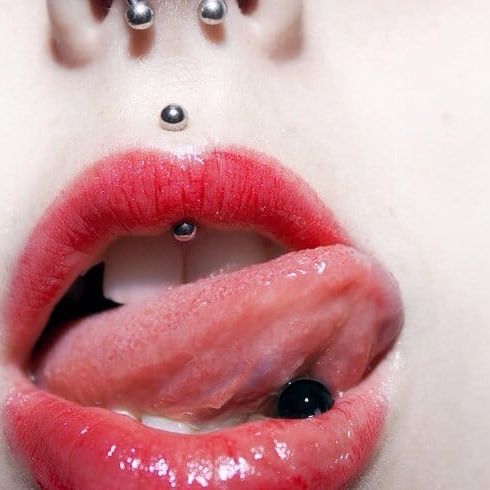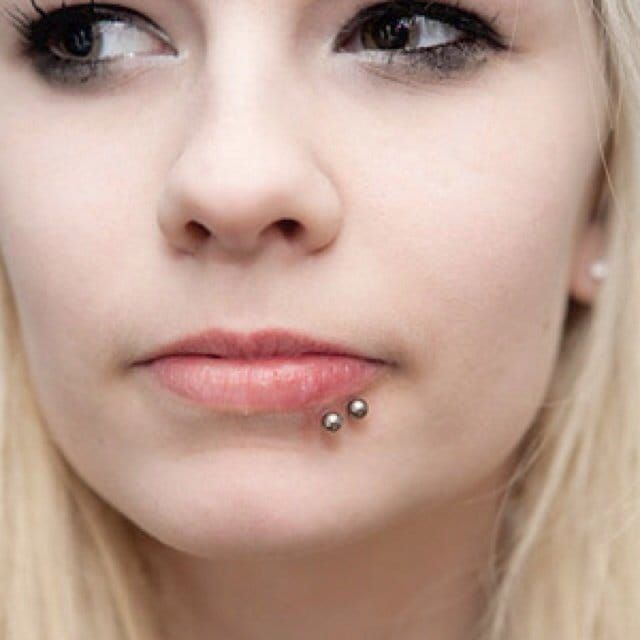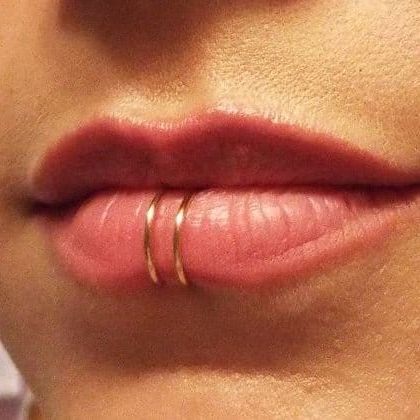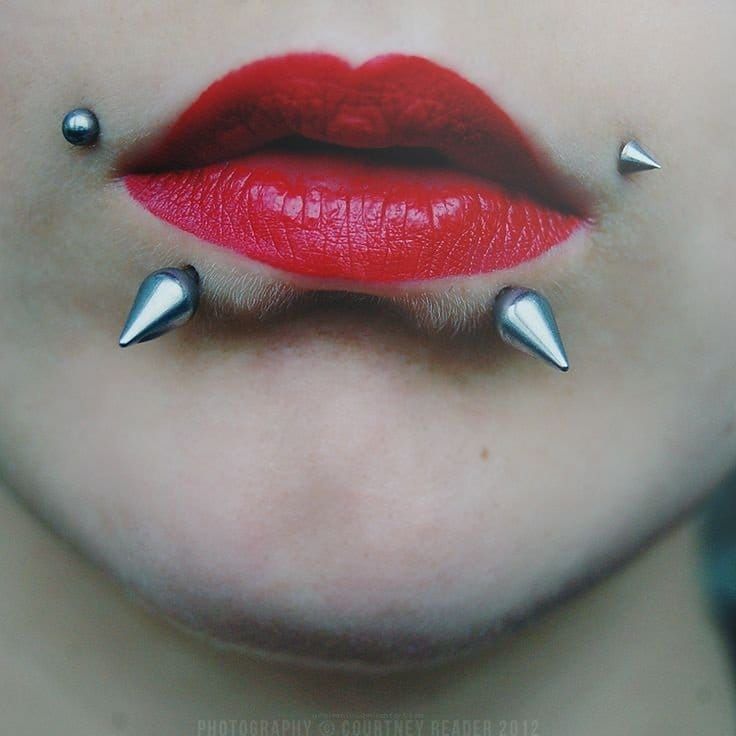Those piercings which are placed in or around the mouth are called oral piercings. Piercings like tongue piercings, lip piercings, and cheek piercings fall under this category. Piercings on the lip and tongue may also be considered facial piercings, however, they heal and require maintenance quite differently than facial piercings.
What Are Mouth Piercings?
You can wear jewelry through an oral piercing (mouth piercing). This is a small hole in your tongue, lip, cheek, or uvula (the tiny tissue that hangs at the back of your throat) where it is possible to wear jewelry
Types of Mouth Piercings
An intraoral piercing can be done on the inside of your mouth (intraoral) or an extraoral piercing can be seen from the outside of your mouth (perioral). The most popular places you can get pierced are:
- Tongue
- Lip
- Cheek
- Frenum (the tissue connecting the tongue or lips to the gums or floor of the mouth)
- Uvula (the tissue hanging at the rear of the throat)
1. TYPES OF LIP PIERCINGS
Bottom Lip Piercing – Labret
In terms of bottom lip piercings, labret lip piercing is one of the most popular options. Labrets are horizontal piercings placed alongside the sides of the bottom lip or below its center.
A type of piercing with this type of healing takes about 1-2 weeks before swelling subsides. In order to prevent discomfort during the initial healing process, your piercer uses a larger jewelry piece to provide extra space for the wound. Approximately 3-4 weeks after recovering from your surgery, you can safely switch to a smaller flat back barbell or threadless labret post in size 14 or 16 gauge.
Style, confidence, and warmth are essentials for beauty. This piercing is the perfect complement to those that have hardcore piercings.
Left Upper Lip Piercing – Monroe
Marilyn Monroe is the inspiration behind the Monroe piercing, which takes its name from the pop culture icon. She is mimicking the famous beauty mark of hers above the left side of her upper lip with the piercing. Piercings of this type are usually performed with a 16 gauge flat-back barbell.
Although the healing process for this type of piercing is usually relatively painless, if not cleaned and cared for properly, it can be quite difficult. A Monroe piercing usually heals within 6-10 weeks but may take up to nine months to fully heal.
Center Upper Lip Piercing – Medusa
In the “philtrum”, this unique piercing is typically known as the Medusa piercing or philtrum piercing because it is positioned above the upper lip in the indented groove. Choosing a medusa piercing is a great option if you are looking for an authentically unique mouth piercing.
Piercings of this type are typically carried out with hollow needles of 16 gauge that work best with flat back barbells or push-pin labret posts. In most cases, the healing process takes approximately 6-12 weeks.
Center Vertical Bottom Lip Piercing – Vertical Labret
The vertical labret can work well to enhance your pout since both ends of the jewelry are displayed. This variation of the traditional labret lets you show off both ends. A tongue piercing is an excellent option for people who don’t want to risk damaging their teeth and gums, since the metal jewelry never touches the inside of the mouth. By positioning it outside of the mouth, this particular placement allows for a more rapid healing process. In order to achieve this look, it is common to use a 16 gauge curved barbell.
Double Piercing on Far Sides of Lower Lip – Snake Bites
In traditional snake bite piercings, two different punctures are made on either side of the lower lip, at the far sides of the mouth. Unlike many of the other types of lip piercing, this one requires two separate puncture wounds during healing, which can make it more complicated.
In order to ensure that both sides of the piercing area are lined up evenly, your experienced piercer will mark the area with a washable marker. The dual piercing causes more stress to the body, therefore it is important to maintain clean skin throughout the healing period, which lasts approximately six to eight weeks.
In terms of jewelry, these three styles are highly recommended: captive rings, circular barbells, and labret studs in 14 or 16 gauge.
Piercing Through Center of the Lip – Inverted Vertical Labret
As a labret that is inverted rather than vertical, the Ashley is one of the very few lip piercings that actually penetrate the lips themselves. In this piercing, the lip is pierced once, with the prongs exiting out of the back of the lip inside the mouth.
It is recommended that when selecting jewelry for this piercing, you use flat-backed labrets of 16 gauge because they minimize contact with the teeth. Be careful not to place the jewelry too far back into the mouth, as this can cause painful tooth chipping and gum damage.
An extended healing time of around 4 months is usually required when compared to traditional lip piercings.
Center Vertical Upper Lip Piercing – Jestrum
Jestrum piercings are also known as vertical medusa piercings or vertical philtrum. They are fun, unique, and have a very modern, contemporary look. Vertical piercings are the same as horizontal ones, except they are inserted through the philtrum (indent above the top lip) and exit from the center of the top lip, so both sides of the jewelry are visible.
The length of time it takes to heal this particular piercing is not particularly high, but it is considered to be quite painful. It takes 6-12 weeks for the external healing process to progress, and up to 6 months for the internal healing process.
When piercing the lip with a 16 gauge barbell, it is recommended to use the smaller one.
Double Piercing on Same Side of Lower Lip – Spider Bites
Generally, spider bite piercings are done by creating two punctures on either side of the lower lip, but they can be done on either side of the upper lip as well. When it comes to side lip piercing, placement is something that is highly important. The perfect spider bite is created when there is the right amount of distance between the holes, as it reflects the real bite of a spider. Consult your piercer if you’d like to make sure there is just the right amount of space between the holes.
On average, this piercing takes between three and four months to heal. During the healing process, it is extremely important that you maintain good dental hygiene.
The most commonly chosen jewelry pieces for this piercing are captive rings, labret studs, and circular barbells.
Piercing above Right Side of Upper Lip – Madonna
The Madonna mouth piercing is a great choice for someone looking for something sexy and subtle. An adornment that pays homage to Madonna’s famous beauty mark sits above the upper right side of the lips.
The healing time for this type of oral piercing can vary from 6-10 weeks to 9 months, but the pain level for the piercing is quite low. In order to prevent this situation, it is crucial to clean and disinfect the area on a consistent basis, typically using a salt solution.
For Madonna piercing, jewelry such as pushpin posts and labret studs are recommended.
Double Piercing on Opposite Sides above Lip – Angel Bites
In the event that you can’t decide between Monroe or Madonna, you can always combine both upper lip piercings with angel bites. The look is created by creating perforations on opposite sides of the area above the upper lip.
There is a higher risk of infection and a longer healing time with a double piercing. Maintain good oral hygiene and keep the necessary areas clean to ensure the area is free of bacteria. Typically, this piercing takes between four and twelve weeks to heal.
Double Piercing above Upper Lip and Beneath Lower Lip – Cyber Bites
In the process of creating cyber bites, you can combine the medusa piercing with a center labret. You won’t see many people sporting this edgy and unique look than other types of mouth piercings, so if you’re looking for something different, then this is the one for you.
There are certain risks associated with this piercing due to the jewelry that will be inserted into the mouth. When using a flat back labret stud or pushpin post, it is advised to use a well-fitting one to minimize potential damage to teeth or gums. Alternatively, you can also use a captive ring for the bottom lip provided that you are cautious of contact with the teeth.
During the healing process, which generally lasts between 6-8 weeks, keeps the area clean as much as possible.
Double Piercing Below Center of Bottom Lip – Dolphin Bites
The dolphin bite is done by piercing two holes beneath the center of the lower lip at close distances. In terms of where you would like to pierce this ear, it depends entirely on the type of jewelry you plan to wear. In addition to being commonly seen close to the lip, dolphin bites can sometimes be worn down towards the chin.
A single piercing may not feel as painful as two separate ones, but two piercings at once may hurt more. Healing can take between 6 and 8 weeks on average.
Double Piercings on Each Corner of the Mouth – Dahlia Bites
Due to its unusual design, this double piercing is sometimes referred to as the “joker” piercing, which gets its name from the gruesome black dahlia murder. It is usually the 14-16 gauge Labret studs that are best suited to this type of look.
It can take between 12-20 weeks for the mouth to heal, but with good oral hygiene and proper treatment aftercare, the process can be accelerated.
Four Piercings on Outer Edges of Upper and Lower Lip – Canine Bites
Dog bites are an awesome way to experiment with your look if you are seeking an unusual oral piercing. Each of the four perforations covers both the upper and lower edges of the mouth. The piercings total four in number. If you feel like this piercing will complement your facial structure, then consider it before you have it done, as it will become a main focal point of attention.
The healing time for piercings caused by dogs bites is usually 8-12 weeks, depending upon the care given afterward.
Two Double Piercings on Opposite Side of Lower Lip – Shark Bites
There are two piercings on either side of the lower lip in the shark bite piercing. The piercing is designed to include four piercings in total. Labret piercings are less common than traditional versions, and this unique look really enhances the lower lip.
If you want to choose jewelry for this piercing, you should use a 16 gauge, but you can also use a 14 gauge. There are many different jewelry types available for this piercing, including labret studs, captive rings, and circular barbells.
The healing process should take 8-12 weeks.
2. TYPES OF TONGUE PIERCINGS
Piercing in Middle of Tongue – Standard Tongue Piercing
When you want a classic and fun tongue piercing, the standard, or middle line tongue piercing, is an excellent choice.
There are no reports of severe pain following this type of piercing, but discomfort may linger for a few days afterward. It normally takes 4-6 weeks for this tongue piercing to heal, depending on the type of piercing. If you remove jewelry for an extended period of time, the wound will quickly close up. Make sure the area is always clean and the jewelry is not removed for any prolonged time. It is also important not to bite down on the jewelry or play with it as this can cause damage to the enamel, chips in the teeth, and receding gums.
Double Horizontal Tongue Piercing – Venom Piercing
It can also be called a “frog eye” piercing. The venom tongue piercing alternates with the traditional midline tongue adornment in an edgier fashion.
During the initial healing process, this piercing will cause swelling and discomfort, but pain levels for this piercing are moderate. In order to reduce the risk of infection, your piercer may perform the piercings one at a time. A healing time of approximately 4-6 weeks is expected after this type of piercing.
Jewelry for this piercing is usually made up of rings 14-16 gauge in size.
Piercing Beneath Tongue – Tongue Web Piercing
Those looking for something more personal can enhance their look with this hidden tongue piercing. By perforating the area of connective tissue connecting the lower gum plate to the tongue, one can achieve tongue web piercing.
In spite of the fact that the piercing is relatively painless, the healing process can often be extremely uncomfortable. Initially, you may experience difficulty eating and maintaining a regular tongue function, but after some adjusting, the piercing will be hardly visible.
A 16 gauge short curved barbell or circular rings are commonly used for this look. Almost anything that is curved will work well with the shape of your mouth and help you feel more comfortable.
3. TYPES OF INNER MOUTH PIERCINGS
Back of the Throat Piercing – Uvula Piercing
Some self-proclaimed piercers who want a hidden piercing have experimented with the uvula piercing. The uvula plays an important role in our digestive, respiratory, and immune systems, as it closes off the nasopharynx, secretes saliva, and helps prevent harmful pathogens from entering the respiratory system. Since this area is responsible for all of these important functions, it is known to cause some complications with certain types of piercings. Among the most common problems are snoring, sleep-related breathing disorders, and unprovoked gag reflexes.
This piercing has a very quick healing time, which is usually about two weeks. When a person is healing, he or she may feel as though their throat is a bit sore.
Piercing on Each Side of Cheek – Dimple Piercing
Piercing of the Lower Gum Tissue – Frowny Piercing
The frowny piercing is also referred to as the frenulum. It provides a cool aesthetic enhancement to the inner mouth. In order to achieve this look, a needle is passed through the thin track connecting the bottom lip to the gumline.
In advance of the actual procedure, your piercer will check to make sure that the tissue in your body is thick enough to sustain the piercing. As this piercing is common to migrate and may end up being rejected, you should take caution and inform yourself thoroughly before undergoing the process. There is also the possibility of jewelry damaging gums and teeth.
Proper aftercare should allow the healing process to be completed in about 4-6 weeks.
Piercing of the Upper Gum Tissue – Smiley Piercing
There has been an increase in the popularity of smiley piercings in recent years as a way to enhance one’s smile in a subtle manner. Piercing this particular area involves puncturing a tissue called the frenulum, located near the gum line between your upper lip and gums.
This type of piercing typically involves thin tissue, which means the level of pain will be very low. A piercer must ensure that you have tissue that can support the jewelry before the procedure can begin.
It is possible for the enamel on your teeth to wear down, and there is also the potential for gum recession and rejection after this piercing.
The healing time for a smiley piercing ranges from four to twelve weeks.
Piercing on the Upper Frenulum – Vampire Piercing
It involves one or more piercings in the upper frenulum under the upper lip, the tissue that connects the lip to the gum. The vampire piercing is very similar to the smiley tattoo.
4. IN-MOUTH PIERCINGS
What is an In-Mouth Piercing?
There are several different types of in-mouth piercings. Body modification has become one of the most popular options for people who want to enhance their appearances. However, some difficulties can arise when this type of piercing is performed. It’s important to have the proper placement in order to avoid a speech impediment in the future. A frenulum piercing is a small hole or incision that is made across the thin line of tissue (frenulum) connecting your bottom lip to your gums. People who want a piercing they can hide often opt for this kind of piercing because it is usually invisible when not intentionally exposed.
A smiley piercing is done in the upper lip frenulum, the thin layer of connective tissue that connects your upper lip to your gums, also known as a scrumper piercing. The name derives from the fact that this piercing can often be seen when you smile.
Pain and Healing Time
Based on the type of in-mouth piercing you choose, your experience may vary to a certain extent. Generally speaking, “the piercing that is done first will hurt the least, the piercing that is done last will hurt the most,” told Brian Keith Thompson, owner and Chief Piercing Officer of Body Electric Tattoo in Los Angeles. “It’s tolerable; you can do it. Just muster up the courage.”
The pain of a standard tongue piercing may be less than that of some alternative locations.
Usually, tongue piercings are done with needles of approximately 10 to 14 gauge. A patient might experience swelling and soreness for up to four weeks. As long as you’re healthy and follow proper aftercare instructions, a smiley piercing or tongue web piercing should heal in about four weeks. Healing times may vary from one person to another, however. “Piercings are a patience game,” Thompson claims, adding that most will take “at least 10 to 12 weeks to heal.“
Cost of an In-Mouth Piercing
In-mouth piercings can range from $200 to $500 depending on the type and price of the jewelry you choose. Jewelry is usually sold separately from the piercing itself in most of the piercing services. Don’t go to a salon that offers too cheap a service – if they advertise a mouth piercing for $20 or less, run. “You think you’re getting a deal, but you’re really not, so definitely spend the money,” explains Thompson. The care or treatment of mouth piercings is especially delicate because they can lead to permanent damage if handled poorly.
“If it’s really cheap and they’re offering deals, I would say that’s a red flag. If you’re good at what you do, you don’t have to offer a discount,” Thompson adds.
Aftercare
Sea salt rinses are usually advised by most piercers throughout the healing process. “After oral piercings, make sure to rinse the mouth often with non-alcoholic mouthwash after eating and before bed. Make sure not to share food or saliva with others during the healing process to avoid infection,” recommends dermatologist Dr. Shari Sperling. “A barbell in your mouth, or any type of metal, will harbor a little bit more bacteria. So, if you do have one of these piercings, you need to make sure that you’re keeping your oral hygiene up to par and brushing the jewelry, the backside of it, cleaning it, getting all the plaque and bacteria off,” adds Thompson.
Some people have been barred from smoking or even using harsh mouthwash while their tongues are healing. It is actually recommended that you avoid kissing and oral sex during the healing process, at least when the wound is fresh. Additionally, excessive cleaning of the piercing can sometimes lead to infections. Do not panic if you experience some irritation. “Most of the time, it’s not an actual bacterial infection, it’s an irritation from trauma from cheaper jewelry, jewelry laden with nickel, or, sometimes, the client is just a little too overzealous with cleaning it,” says Thompson. “They think, ‘well now I’m going to clean it three times a day, and I’m going to cover it with alcohol and antibiotic ointment,’ and that is not going to fix the problem. The problem is that you need to leave it alone.”
What Type of Jewelry Is Used for In-Mouth Piercing?
- Curved barbell: In general, this is the most popular type of jewelry for a new tongue or lingual frenulum piercing; it consists of a curved bar with balls on either side, one of which is removable for easy application. According to Thompson, customers opt for this style of jewelry since it remains relatively stationary over time, which is a good thing for those looking to get an in-mouth piercing. “The more the piercing is rotated, the longer it’s going to take for it to heal.”
- Captive bead ring: A hoop with a hole in the center is popular with new tongue piercings, and it is a style that is usually worn under the tongue. The frenulum piercings with these are popular with people with frowny faces.
- Circular barbell: A circular barbell is usually used in conjunction with smiley frenulum piercings if delicate jewelry is to be used. As the horseshoe-shaped barbell is in fact circular, the term “circular” is misleading.
What Jewelry Material Is Used for In-Mouth Piercing?
- Titanium: Tompson prefers gold and titanium as “hypoallergenic metals” that do not contain nickel. “Nickel is not going to kill you. It’s not going to poison you, but it can cause slower healing.”
- Gold: Likewise, gold is a good metal to use for mouth piercings since it is a softer metal and may be less likely to damage teeth and gums, according to Thompson. Make sure you shop for quality, solid gold jewelry rather than gold-plated jewelry since the latter can flake off and lead to infection.
Oral Piercing Risks and Complications
This is one of the many ways to express your personality, but it can also be dangerous. Among the many bacteria in your mouth are those that cause infection and swelling. You may find that breathing becomes difficult when you have a swollen tongue. Some people with heart disease may develop a condition that can damage their heart valves if they are exposed to bacteria.
Additionally, tongue piercings expose you to bleeding risks. An area of your body is filled with blood vessels.
It is also possible for the jewelry to cause issues. Occasionally pieces of jewelry will fall into your mouth and you may choke. When you chew on it, eat on it, sleep on it, talk on it, or chew on it, your teeth may chip off. Your tooth may be lost if the break is deep enough to cause a root canal or it may need to be fixed with a crown.
The following may also occur with mouth piercings:
- Having difficulty speaking, chewing, or swallowing
- Injure your tongue, gums, or fillings
- Almost makes you drool
- Your dentist may have difficulty taking an X-ray of your teeth if you make it difficult for him/her
- These conditions such as gum disease, uncontrolled bleeding, long-term infections, hepatitis B, and hepatitis C can have serious health effects
- The metal in the jewelry may cause an allergic reaction
- Damage the nerves in your tongue, a condition that is usually temporary, but occasionally long-lasting because of these risks, the American Dental Association recommends you avoid oral piercings. Furthermore, you should stay away from getting a piercing if you have conditions that may not allow the piercing to heal well. People with conditions that could make the piercing more difficult to heal are especially at risk. Cardiovascular diseases, diabetes, hemophilia, and autoimmune diseases are among them.
Oral Piercing Safety
If you are considering getting an oral piercing, make sure that you are up-to-date on your hepatitis B and tetanus vaccines.
Consider piercing shops with a clean and professional appearance. A licensed piercer has had special training, so you can be sure they know how to perform the piercing.
After piercing, the piercer’s hands should be cleaned with antiseptic soap, disposable gloves should be worn, and the tools should be sterilized or thrown away after being used once.
The following things need to be considered:
- If you have any questions, the piercer would be happy to answer them.
- Those who work at the store have been vaccinated against hepatitis B. (It’s okay to ask.)
- Neither the shop nor its employees use piercing guns.
- There is a new needle that has never been used.
- Once a needle has been used, it is placed in a sealed container.
- In addition to surgical steel, platinum, and solid gold, jewelry can also be made of surgical steel.
Oral Piercing Care
- Always rinse your tongue or lip piercing after eating or snacking, as well as before going to bed.
- Afterward, rinse your mouth with warm salt water or an antibacterial, alcohol-free mouthwash.
- During your healing process, do not kiss anyone. (Avoid contact with another individual’s saliva.)
- Never share your cups, plates, forks, knives, or spoons
- Healthy food should be eaten in small portions.
- Spices, salt, and acidic foods should not be consumed
- Hot drinks, like coffee, tea, or hot chocolate, should not be consumed
- Keep a gentle attitude. Take care when you talk and chew, and try not to clench your teeth with your jewelry.
- It is important to check your jewelry every once in a while to prevent choking or swallowing.
- Wear a mouthguard while playing sports, and remove your jewelry.
The piercing should heal adequately for you to remove your jewelry for brief periods without closing the hole. In order for a tongue piercing to heal properly, the piercer will begin with a larger “barbell” to allow enough room for swelling. Dentists recommend replacing the large barbell with a smaller one that won’t bother your teeth once the swelling is gone. After your tongue heals, you should take the jewelry out every night and brush it like you do your teeth. Before going to sleep or doing anything physical, you should probably take it out.





























